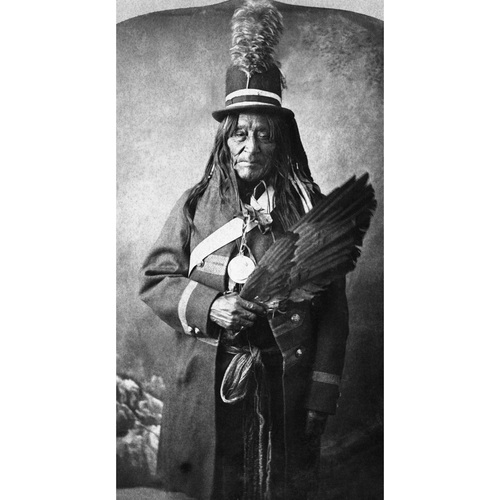
Source: Link
NATOS-API (Old Sun or Sun Old Man, also known as White Shell Old Man), Blackfoot Indian chief and medicine man; b. c. 1819 probably in what is now central Alberta, son of Natos-api (Old Sun, also known as Crockery Old Man); d. 26 Jan. 1897 at North Camp Flats on the Blackfoot Indian Reserve south of Gleichen (Alta).
Old Sun was born at a time when the Blackfoot tribe controlled much of what is now central Alberta south of the Battle River. His father was a leading chief of the tribe and head of the All Medicine Men band, which hunted in the northern part of Blackfoot territory. As a young man, Old Sun, known as White Shell Old Man until his father’s death in 1860, gained an enviable war record. Unlike most others in the tribe, he did not give up the war-path as he grew older, and he continued to lead horse-raiding expeditions against other tribes well into his adult years. Red Crow [Mékaisto], later a Blood chief, was with one such war party in the 1850s, when three Plains Cree were killed outside their camp on the North Saskatchewan River. In later years Old Sun carried a blond scalp said to have been taken from a young German girl during an attack on a wagon train in the Porcupine Hills. Old Sun’s main wife, Calf Old Woman, was also known for her sang-froid and ferocity in battle, and was one of the few women to sit as a warrior in Blackfoot councils.
Like his father, Old Sun was famous as a medicine man. In his youth he had camped on a secluded hill in a quest for a vision and he believed that he had received supernatural powers from the deer. He carried a deer’s shin-bone which he used for healing and for warding off evil. He also had an amulet used for curing blindness. A classic story is still told by the Blackfeet of a confrontation between Old Sun and a Cree medicine man in which Old Sun’s deer powers triumphed over all the incantations of his enemy.
Following his father’s death at the hands of Cree Indians near Fort Edmonton (Edmonton), Old Sun became leader of the All Medicine Men band and, together with Akamih-kayi (Big Swan) and Nookskatos (Three Suns), a head chief of the tribe. Just prior to the smallpox epidemic of 1869–70, American authorities estimated that Old Sun’s band consisted of 26 lodges with 312 persons including 78 warriors. The smallpox epidemic and other diseases carried off a number of chiefs, and by 1872 Old Sun and Crowfoot [Isapo-muxika*] emerged as the two head chiefs of the tribe. Less interested in the political functions of leadership than his fellow chief, Old Sun left discussions with Canadian officials after the arrival of the North-West Mounted Police in 1874 [see James Farquharson Macleod] to the much younger Crowfoot. In 1877 when the native leaders of the western Prairies gathered to negotiate Treaty No.7, Old Sun signed for his band but deferred in the negotiations to Crowfoot.
The Blackfeet settled on their reserve in 1881, and Old Sun took his people upstream from Crowfoot’s camp at Blackfoot Crossing (Alta) to settle at North Camp Flats. He showed no interest in farming and was criticized by Indian Agent Magnus Begg in 1884 as “very poor for working in his band, and he is too old to do much work himself.” In 1883 Old Sun had agreed to let Anglican missionary John William Tims stay in his camp, but had marked off an area for him only eight feet square. At first suspicious that the missionary was trying to steal his land, he expanded the plot later that year for a house and a mission to be built. Anglican missionary Harry William Gibbon Stocken met Old Sun two years later and described him as “a remarkable old man; never weary of describing his prowess in younger days. His splendid physique was evidence of this. . . . He sat there with an air of importance, his whole body besmeared with brick-red paint.” Although Old Sun never converted to Christianity, he supported the Anglicans and enrolled two of his grandchildren as the first students in the mission school.
Old Sun withdrew almost entirely from tribal politics in the 1890s, but remained a respected patriarch and religious figure until his death in 1897.
NA, RG 10, CII, 1136, 30 June 1884. Private arch., H. A. Dempsey (Calgary), interviews with Ayoungman and Heavy Shield, Blackfoot Indians, 10 July 1954 and 8 March 1957 respectively. Morris, Treaties of Canada with the Indians. Calgary Herald, 29 April 1933. Saskatchewan Herald, 12 Feb. 1897. H. A. Dempsey, Crowfoot, chief of the Blackfeet (Edmonton, 1972); Red Crow, warrior chief (Saskatoon, 1980). S. H. Middleton, Kainai chieftainship; history, evolution, and culture of the Blood Indians; origin of the sun-dance ([Lethbridge, Alta., 1953]). Julian Ralph, On Canada’s frontier: sketches of history, sport and adventure and of the Indians, missionaries, fur-traders, and newer settlers of western Canada (London, 1892). C. H. W. G. Stocken, Among the Blackfoot and Sarcee (Calgary, 1976).
Cite This Article
Hugh A. Dempsey, “NATOS-API (Old Sun, Sun Old Man, White Shell Old Man),” in Dictionary of Canadian Biography, vol. 12, University of Toronto/Université Laval, 2003–, accessed March 31, 2025, https://www.biographi.ca/en/bio/natos_api_12E.html.
The citation above shows the format for footnotes and endnotes according to the Chicago manual of style (16th edition). Information to be used in other citation formats:
| Permalink: | https://www.biographi.ca/en/bio/natos_api_12E.html |
| Author of Article: | Hugh A. Dempsey |
| Title of Article: | NATOS-API (Old Sun, Sun Old Man, White Shell Old Man) |
| Publication Name: | Dictionary of Canadian Biography, vol. 12 |
| Publisher: | University of Toronto/Université Laval |
| Year of revision: | 1990 |
| Access Date: | March 31, 2025 |



